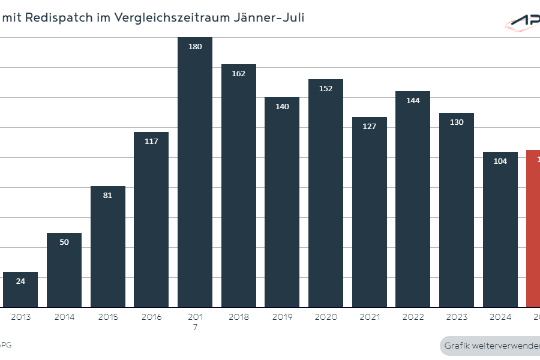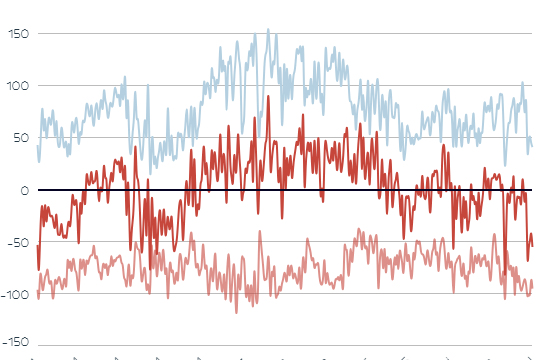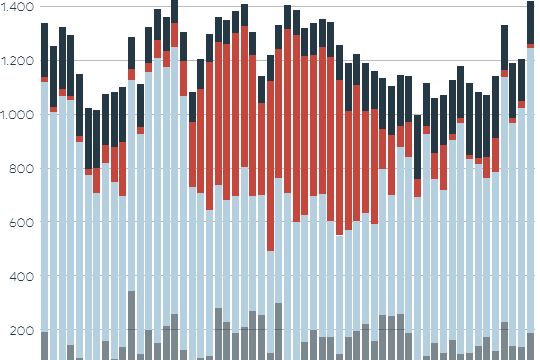Above-average precipitation in July resulted in Austria becoming a net electricity exporter. In July (calendar weeks 27-31), run-of-river feed-in developed favorably. While it was still below the long-term seasonal average at the beginning of the month at 508 GWh in calendar week 27 (historic seasonal minimum value on June 30), it increased to a notable seasonal maximum by the end of the month at 904 GWh in calendar week 31 (historic seasonal maximum value on July 28). This is almost a doubling.
"If we only look at run-of-river hydropower generation, July was a month of extremes. Overall, however, the heavy rainfall towards the end of the month compensated for the arid conditions at the beginning. Electricity production in July was good, thanks to only a very slight decline in generation from renewables. Austria was a net electricity exporter in July," says Gerhard Christiner, CTO of Austrian Power Grid (APG).
Total renewable generation in July 2025 (CW 27–31) amounted to 6,075 GWh, which is a slight decrease of 2.9% compared to July 2024. The share of PV generation decreased by 2.5% (780 GWh generation volume), while the share of hydropower remained nearly stable with only a 1.2% reduction (4,346 GWh generation). Wind energy was the only source to record growth, rising by 3.9% (817 GWh generation). Despite the modest year-on-year decline, renewables still accounted for around 93.5% of the total feed-in in July.
On balance, exports in Austria (APG control area*) amounted to 458 GWh (based on schedules) over the entire month of July 2025, with electricity being exported on 22 days. Austria was also an export country in July 2024, although the balance was higher at 997 GWh, and electricity was exported on all 31 days of the month.
Electricity grids for trans-regional electricity exchange
The volatility of the electricity system, the growing need to integrate renewables, and the increasing occurrence of electricity surpluses across regions and at certain times highlight the importance of an efficient grid. “In the face of a challenging overall situation in the energy industry, it is crucial to anticipate these developments and ensure better coordination for a cost-efficient transformation of the energy system. The expansion of renewable generation must go hand in hand with the expansion of the grid infrastructure—otherwise, there will be no capacity to accommodate additional renewables," says Christiner.
The volatility of the electricity system in Austria requires the targeted and controlled use of power plants to absorb grid overloads. By the end of July 2025, redispatch measures incurred costs of EUR 53.0 million, an increase of EUR 5.3 million compared to July 2024. In the first seven months of 2025, a total of 10,485 MWh of electricity (around 1,498 MWh per month on average) was “lost” through redispatching because the output of renewable power plants had to be reduced. To date, interventions have been necessary on 105 days, only slightly higher than the 104 days recorded by the end of July 2024. However, the continued need for redispatching highlights the urgency of expanding grid capacity.
Energy exchange within Austria
Only with the help of a high-capacity transmission grid can electricity surpluses in individual provinces be distributed throughout Austria to compensate for deficits.
In July 2025, the energy exchange within Austria can be summarized as follows: Lower Austria (421 GWh) and Upper Austria (287 GWh) fed the highest amounts of energy into the APG grid and thus made it available throughout Austria, while Vienna (450 GWh) and Carinthia (173 GWh) drew the most electricity from the APG grid.
Increasing electrification
Our electricity system faces the challenges of the increasing electrification of all areas of life and the economy, which is reflected in high electricity consumption. Based on the latest available data, 5,493 GWh of electricity were consumed from the public grid in Austria in July 2025 (CW 27-31)**, this is an increase of around 7.2% compared to July 2024 (5,125 GWh) and can be seen as a continuation of the general trend of rising electricity consumption. The higher withdrawal from the public grid was reinforced by lower PV self-generation behind grid connections, as July 2025 recorded fewer hours of sunshine than the same month last year.
* The APG control area covers all of Austria with the exception of one corridor each in Vorarlberg and Tyrol.
** This is the electricity consumption from the public grid (including grid losses, excluding pumped storage) in the APG control area. The figures do not include electricity produced and consumed by private PV units.
About Austrian Power Grid (APG)
As independent transmission system operator Austrian Power Grid (APG) is in charge of ensuring the security of the electricity supply in Austria. With our high-performance and digital electricity infrastructure and the use of state-of-the-art technologies we integrate renewable energies and reduce the dependency on electricity imports, we are the platform for the electricity market, and we provide access to reasonably priced electricity and thus create the basis for Austria as supply-secure and future-oriented industrial and business location and place to live. The APG grid totals a length of about 3,500 km and is operated, maintained, and continuously adapted to the increasing challenges of the electrification of businesses, industry, and society by a team of approximately 1,000 specialists. 67 substations are distributed all over Austria and the majority is operated remotely. Thanks to our committed employees Austria had a security of supply of 99.99 percent also in 2024 and thus ranks among the top countries worldwide. Our investments of 630 million euros in 2025 (2024: 440 million euros, 2023: 490 million euros) are a motor for the Austrian economy and a crucial factor in reaching Austria’s climate and energy targets. Until 2034 APG will invest a total of approximately 9 billion euros in grid expansion and renovation projects.
Press contact
Christoph Schuh




